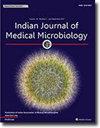印度一家医院耐多药肺炎克雷伯菌的传播动力学
IF 1.3
4区 医学
Q4 IMMUNOLOGY
引用次数: 0
摘要
目的肺炎克雷伯菌的传播正成为人们关注的主要问题,因为这种微生物是造成医院获得性感染的重要原因。由于这种生物的复杂性,高度需要对与传播相关的流行病学和感染控制实践有足够的了解。因此,本研究设计包括连续的环境和患者样本,以评估不同来源的分离株之间的相似性模式。方法纳入医院获得性肺炎克雷伯菌感染患者和环境分离菌。采用Illumina MiSeq 250 2 × 250 bp配对端(Illumina, USA)和Nanopore (Oxford)对48个分离株进行测序,获得完整序列。其中包括30例BSI, 13例环境和5例水。用Unicycler制备了高质量的reads。利用Abricate的Resfinder进行AMR基因检测,并通过基于SNP的系统发育分析观察序列相似性。结果最常见的微生物序列类型为ST 231和ST 395。ST - 29在水分离株和临床分离株之间普遍存在。临床分离株AMR基因平均(范围)数为16个(3-24个)。共有41个抗菌基因,其中fosA基因较为普遍。blaNDM占55.4% (27/48),blaOXA占61.6%(30/48)。菌株ST 395和ST 16携带的细菌数量最多。复制子n = 10和n = 9。主要质粒复制子Col440I (N = 58),其次是IncFII_1_pKP91 (N = 34)和ColRNAI (N = 29)。系统发育分析显示临床样本与环境样本高度相似。结论环境因素是导致医院获得性感染率上升的重要因素。因此,迫切需要实施感染控制措施,以防止传染病的传播。本文章由计算机程序翻译,如有差异,请以英文原文为准。
Transmission dynamics of multidrug resistant Klebsiella pneumoniae from an Indian hospital
Object
The dissemination of Klebsiella pneumoniae is becoming a major concern, as this organism is responsible for a significant proportion of hospital acquired infections. Due to complexity of this organism adequate knowledge on the epidemiology and infection control practices associated with the dissemination is highly required. Therefore, this study designed to include consecutive samples from environment and patients to assess the similarity pattern among isolates from different sources.
Methodology
We included patients with hospital acquired infections with K. pneumonaie and environment isolates. To obtain the complete sequence forty-eight isolates were sequenced on Illumina MiSeq 250 2 × 250 bp paired end (Illumina, USA) and Nanopore (Oxford). These includes 30 BSI cases, 13 environment and 5 from water. Assembly of good quality reads were prepared using Unicycler. AMR gene detection was done using Resfinder of Abricate and sequence similarity was observed by SNP based phylogenetic analysis.
Results
The most common sequence type of organism among all was ST 231 and ST 395. ST 29 was common between water and clinical isolates. Average (range) number of AMR genes present in clinical isolates were 16 (3–24). The antimicrobial genes belong to 41 classes and fosA was highly prevalent. The frequency of blaNDM was present 55.4 % (27/48) and blaOXA in 61.6 % (30/48). The strain ST 395 and ST 16 carried highest no. of replicons n = 10 and n = 9. The predominant plasmid replicon Col440I (N = 58) followed by IncFII_1_pKP91 (N = 34) and ColRNAI (N = 29). The phylogenetic analysis showed high similarity between clinical and environmental samples.
Conclusion
This study concludes that environment play essential role in disseminating the infectious strains of organism resulting in increased rates of hospital acquired infections. Therefore, there is an imperative necessity for implementing infection control practices to prevent the spread of infectious diseases.
求助全文
通过发布文献求助,成功后即可免费获取论文全文。
去求助
来源期刊

Indian Journal of Medical Microbiology
IMMUNOLOGY-
CiteScore
2.20
自引率
0.00%
发文量
154
审稿时长
73 days
期刊介绍:
Manuscripts of high standard in the form of original research, multicentric studies, meta analysis, are accepted. Current reports can be submitted as brief communications. Case reports must include review of current literature, clinical details, outcome and follow up. Letters to the editor must be a comment on or pertain to a manuscript already published in the IJMM or in relation to preliminary communication of a larger study.
Review articles, Special Articles or Guest Editorials are accepted on invitation.
 求助内容:
求助内容: 应助结果提醒方式:
应助结果提醒方式:


